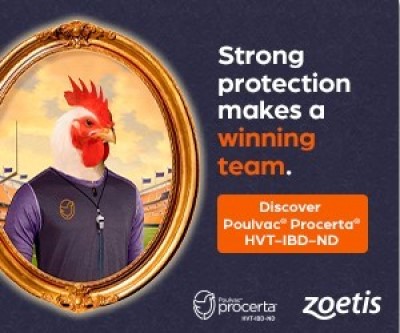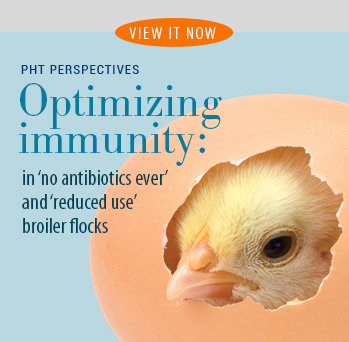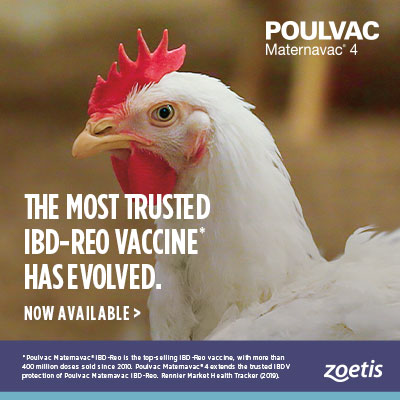Conventional, recombinant MD vaccination protocols compared in long-lived birds
An interview with Eduardo Muniz, DVM, Zoetis
Q: Vaccination of breeders and layers to protect them from Marek’s disease (MD) remains vitally important, and producers have more options now than ever before. Recently you and colleagues conducted a study comparing different protocols. What exactly was the objective of the study?
EM: We wanted to determine how a conventional program measures up against some of the newer protocols utilizing recombinant herpesvirus of turkey (HVT) vector vaccines. We also wanted to determine if adding an immune-complex infectious bursal disease (IBD) vaccine would interfere with MD vaccine performance.1
Q: Explain the study design.
EM: We started with 300, day-old female birds, then divided them into groups of 100 that were vaccinated post-hatch by subcutaneous injection. Each group received one of the following protocols:
- Group 1: A recombinant, vectored HVT-IBD vaccine combined with a conventional Rispens CVI-988 strain of MD
- Group 2: A conventional combination vaccine with HVT and the Rispens CVI-988 MD strain (Poulvac® Ovoline CVI+HVT), plus an immune-complex IBD vaccine with the V877 strain (Magniplex®)
- Group 3: A different recombinant vectored HVT-IBD vaccine plus a different Rispens CVI-988 strain of MD compared to group 1
We then compared replication, which reflects the onset of immunity, and the percentage of vaccine coverage in each group.
Q: How did you determine replication and coverage?
EM: We took pulp-rich feather-tip samples from each group at 14, 21 and 28 days of age, then sent them to a laboratory where they were tested by real-time polymerase chain reaction (PCR) for both HVT and the CVI-988 components of the vaccines. Both components protect against MD. Specifically, the PCR assays amplified and quantified sequences of genes for CVI serotype 1 and for HVT serotype 3. The combination of these serotypes has been an important and effective control strategy for vaccination of long-lived birds.
Q: Why did you use feather-tip sampling?
EM: Feather tips are known to be an excellent source for detection and quantification of MD virus. In addition, sampling of feather tips is a noninvasive and less traumatic way to obtain important information from birds.
Q: What were your findings?
EM: The CVI and HVT components of Poulvac Ovoline CVI+HVT clearly provided the fastest replication rates compared to the recombinant groups. Coverage was also better. For instance, at 14 days, the percent positive for CVI was 95% in the Poulvac Ovoline CVI+HVT group compared to 71% and 35% in Groups 1 and 3, respectively. Faster replication and coverage are important if birds are challenged by field viruses early in life.
Q: Were there any other significant findings?
EM: The replication rate was faster and higher with Poulvac Ovoline CVI+HVT even though titers of plaque-forming units per dose (PFU/dose) were lower compared to the recombinant groups. This indicates that a titer expressed as PFU/dose is not a valid basis for comparison.
Q: Did the addition of the immune-complex IBD vaccine have any impact on the results?
EM: Even with the addition of the IBD vaccine, replication of HVT and CVI with Poulvac Ovoline CVI+HVT was the fastest of the three protocols tested. That indicates that adding the immune-complex IBD vaccine to the protocol did not interfere with the efficacy against MD.
Q: Can the results be extrapolated to other classes of commercial poultry?
EM: They cannot. All of the commercially available MD vaccines help prevent mortality and the tumors characteristic of MD, and there are pros and cons to each. The HVT recombinant vector vaccines conveniently immunize against both MD and IBD. They also eliminate the side effects that can occur with some of the conventional vaccines, and they provide lasting immunity.
Which vaccine protocol to select will vary with the circumstances. There are numerous factors to consider, including regional field challenge, bird genetics, maternal antibody levels and other pathogens that may be present.
Q: What’s the take-home message from your study?
AG: In long-lived birds, immunoprophylactic programs based on conventional vaccines for MD containing HVT plus CVI-988 replicated better, indicating that, in this case, they were faster and showed greater coverage than the recombinant HVT vectored vaccines combined with the specific CVI-988 vaccines used in this trial. The results of our study should be considered by producers planning an MD-control strategy for breeders and layers, especially if their flocks are confronting early, significant MD and IBD field pressure.
All trademarks are the property of Zoetis Services LLC or a related company or a licensor unless otherwise noted.
1 Muniz EC, et al. Comparison of CVI and HVT vaccine strains replication in feather tips in different Marek’s Disease vaccination programs. ARS Veterinaria, Jaboticabal, SP. 2020;36(4):278-285.
TOOLBOX, Issue 34
Toolbox is a series of interviews with veterinarians and other technical specialists about their experiences managing antimicrobials, vaccines and other tools for poultry health. It is produced by the editors of Poultry Health Today on behalf of the Global Poultry Business of Zoetis.
MM-18238
February 2022
Posted on March 8, 2022


















